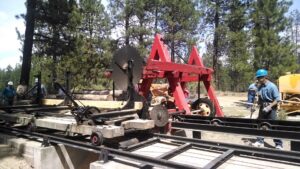Athol, ID – An accident is under investigation at the northern Idaho lumber mill where a worker died in an industrial accident last Friday. A 45-year-old man was fatally injured while trying to clear a broken piece of wood from a machine at the Merritt Brothers Lumber Company. Emergency workers were called to the mill just after 6a.m., and the employee was pronounced dead after being taken to a local hospital.
Lockout Tagout safety procedures are imperative in every industry, but the risk of amputation or death in workplace situations common to lumber and paper mills really highlights the importance of having a comprehensive lockout plan in place to prevent the unexpected energization or startup of machinery and equipment during mainten ance activities.
ance activities.
OSHA requires that equipment specific lockout procedures be written for each piece of equipment. These lockout procedures provide detailed instruction on how to isolate and lock each energy source for a given piece of equipment, which helps to prevent the release of hazardous energy during service or maintenance activities.
Lockout/Tagout procedures should be developed that outline how to isolate any prime movers, and machinery and equipment whose energy sources include mechanical, hydraulic, pneumatic, chemical, electrical, thermal or other. Lockout procedures are to be developed in compliance with OSHA CFR 29 1910.147 and with any state program requirements.
A written lockout/tagout policy (LOTO) is one of 5 key lockout program components required by OSHA and ANSI. The written lockout policy governs the lockout program for the company and provides references for implementing and following a successful safety program. Lockout/Tagout (LOTO) and Hazardous Energy Control refers to the same standard of preventing unexpected start up or movement of equipment. The terms are used interchangably, although “Lockout” is more universally used in the United States as it is the term OSHA uses, while ANSI uses “Control of Hazardous Energy ” in their standard, which is used more often by non-US entities.
Violations of lockout-tagout (hazardous energy controls) are on OSHA’s Top 10 “Most Often Cited Violations” and Top 10 “Most Serious Violations” lists. While many companies have general written policies, they are lacking the equipment specific procedures which provide workers with the specific steps to properly isolate energy sources. Fines for lockout violations are based on each piece of equipment, and can add up to tens or hundreds of thousands of dollars.
The #1 most cited OSHA regulation for manufacturing is Lockout-Tagout (LOTO). LOTO fines from OSHA increased over 65% from 2010 to 2011.
Approximately 3 million American workers service equipment – these employees face the greatest risk of injury if lockout/tagout is not properly implemented. Compliance with the lockout/tagout standard (29 CFR 1910.147) prevents an estimated 120 fatalities and 50,000 injuries each year. Workers injured on the job from exposure to hazardous energy lose an average of 24 workdays for recuperation. In a study conducted by the UAW, 20% of the fatalities that occurred among their members between 1973 and 1995 were attributed to inadequate hazardous energy control procedures specifically, lockout/tagout procedures.
Call a professional on our Safety and Compliance team today to discuss how Martin Technical can bring our expertise and experience to your facility. We genuinely care about people, and are dedicated to getting every one of your employees safely to the best part of their day: getting home!
Read more from original source.
We are here to help you.